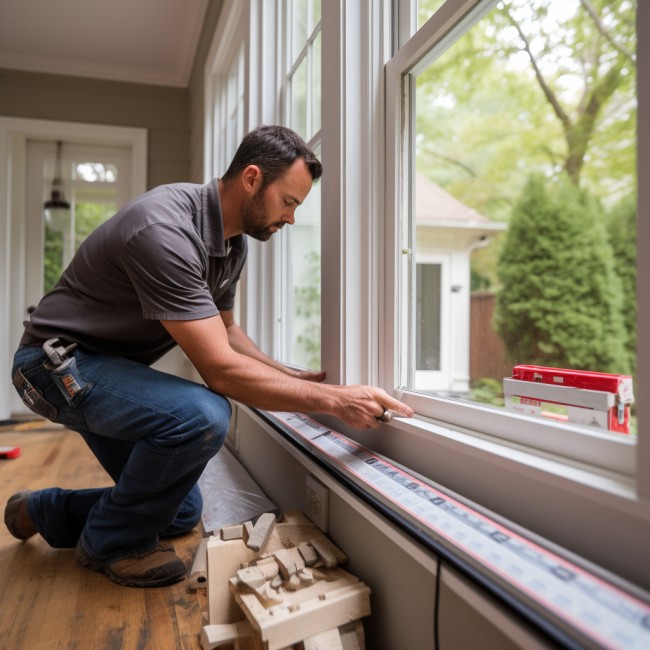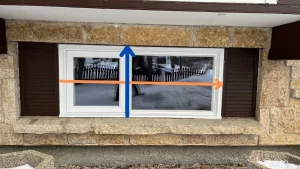The need for home window replacement
It’s essential to assess the condition of your windows regularly and consider replacement if you notice any signs of damage, deterioration, or poor performance. Window replacement is a common home improvement project that can improve energy efficiency, increase comfort, and enhance the appearance of your home. There are several reasons why homeowners may need to replace their home windows. For example:
- Energy efficiency: Old or poorly insulated windows can lead to significant energy loss. By replacing them with newer, energy-efficient windows, homeowners can reduce heating and cooling costs, making their homes more comfortable and environmentally friendly.
- Comfort and insulation: Drafty or leaky windows can result in uncomfortable indoor temperatures. New windows with better insulation properties can help maintain a consistent and comfortable indoor environment.
- Condensation and moisture issues: Condensation between the panes or on the interior surface of windows may indicate seal failure. Moisture-related issues can lead to mold growth, wood rot, and damage to the window frames, necessitating replacement.
- Noise reduction: Upgrading to windows with better soundproofing properties can help reduce outside noise, making the interior of the home quieter and more peaceful.
- Aesthetics and curb appeal: Old, worn-out windows can detract from the overall appearance of a home. Replacing them can improve the aesthetics and curb appeal, potentially increasing the property value.
- Safety and security: Older windows may have outdated locking mechanisms or be easier to break into, compromising the safety and security of the home. Newer windows often come with improved locking systems and stronger materials, enhancing home security.
- UV protection: Modern windows with low-emissivity (low-E) coatings can help block harmful ultraviolet (UV) rays, which can fade furniture, carpets, and other interior furnishings over time.
- Home renovation or remodeling: When renovating or remodeling a home, replacing windows can be part of updating the overall look and functionality of the property.
- Structural integrity: Over time, window frames and sills can deteriorate due to exposure to the elements. Replacing damaged or rotten frames can help maintain the structural integrity of the home.
- Easier maintenance: Some older windows may be challenging to clean and maintain. Newer windows often come with features like tilt-in sashes, making them easier to clean from inside the house.
How to measure for replacement windows?
Measuring for window replacement involves obtaining accurate measurements of your existing window openings to ensure the new windows fit properly.
Disclaimer: It’s important to be as precise as possible when measuring for window replacement to avoid costly mistakes or ill-fitting windows. If you’re unsure about any aspect of the measurement process or the type of window that best suits your needs, consider consulting a professional window installer or retailer to guide you through the process.
Here’s a step-by-step guide on how to do it:
Tools you’ll need:
- Tape measure (preferably a metal one for accuracy).
- Pen/pencil and paper or a note-taking device.
Step 1: Measure width

- Start by measuring the width of the window opening at three different points: the top, middle, and bottom.
- Measure from the inside of the window frame or jamb on the left side to the inside of the frame on the right side.
- Note down the smallest measurement. This will be the width of the window you need.
Step 2: Measure height

- Next, measure the height of the window opening at three different points: the left, center, and right.
- Measure from the inside of the window frame or jamb at the top to the inside of the frame at the bottom.
- Note down the smallest measurement. This will be the height of the window you need.
Step 3: Measure depth

- Measure the depth of the window frame from the interior to the exterior trim. This measurement is crucial to ensure the new window will fit properly in the existing opening.
Consider the wall thickness
Measuring from left to right and from bottom to upper frame is a good start but you also need to know how thick your wall is. Imagine your wall is about 7 inches thick and your new windows are only 3 ¼ inches thick.
You will have about 3 ¾ inches of bare wall that you will have to cover somehow. The best way to measure the thickness of your wall is by opening your window and measuring the thickness of your wall.
Try to align your measuring tape to the inside of your wall and run the tape out the window until you cover the whole depth of the wall. Now you have an approximate measurement of your wall.
Some old windows may not open at all. If your window is too old or if the crank opener is broken and there is absolutely no way for you to open your window to measure your wall, then you can use your entrance door to do the job.
Open your door and find the frame of your door. Measure the depth of your door from left to right. Usually, door depths are about 4-6 inches in Manitoba but you may get different numbers.
Whatever is your number, that is the depth of your door frame and most likely that would be the depth of your wall as well.
Step 4: Check squareness

- To check if the window opening is square, measure the diagonals from the top left corner to the bottom right corner and from the top right corner to the bottom left corner.
- If both diagonal measurements are the same or very close, the opening is square. If they differ significantly, it may indicate that the opening is not perfectly square, and you should take note of the larger measurement.
Step 5: Consider window type
- Decide on the type of window you want to replace your existing one with (e.g., single-hung, double-hung, casement, sliding, etc.).
- Different window types have different installation requirements, so be sure to consult the manufacturer’s guidelines or a professional for specific measurements based on the window type you choose.
Step 6: Ordering the replacement window
- When ordering the replacement window, provide the measurements you obtained. Be sure to order windows with dimensions that match the smallest width and height measurements to ensure a proper fit.
- Some window manufacturers may ask for the exact measurements of the window frame, while others will automatically deduct a certain amount to account for installation clearances. Be clear on the ordering instructions or consult with the supplier to avoid any confusion.
Frame-to frame window measurement
It may seem that is easy to measure your windows if you want to replacement them yourself but in practice it can be difficult and time consuming. One of the popular ways to measure your window size is by measuring the frame of your window. However, measuring the frame can be cumbersome because usually the frame is buried under the casing/trim of the window on the inside of your home. There are two ways you can measure the frame of your windows from inside the use.
First way, is to remove the trim of the window from the inside and then measure the frame from the edge to edge, from left to right. You won’t have to remove both casings, if you remove only one trim you can estimate where the other edge of the frame maybe under the casing.
After you have measure from left to right, it is time to measure from bottom up. After having measured your windows, you will have two numbers like in this example: 26 x 40. The first number is the width of your window and the second number is the height of the frame of your window.
The second way of measure for replacement window is to measure without removing the casings. As a general rule of thumb is that the edge of your frame is located in the middle of the casing/trim of the window.
This rule is mostly true for most houses in Manitoba. Follow the same steps as above by measuring from the middle of the casing without removing the casing from left to right and then repeat the same steps from bottom up. You should have approximately the same results as above, in this example 26 x 40 inches.

Brick-to-brick
A more accurate way of measure your window without removing any trims or casings, would be to measure them from the outside. Your windows on the outside should have clear borders that are called brickmoulds.
Measure your windows from the edge of the brickmould from left to right and right down that number. Repeat the same steps from the bottom of your window’s brickmould to upper brickmould.
Now, this number will be bigger than your measurements from inside the home. Your windows may have different brickmould size on the outside, and if for example your windows have a brickmould of 2 inches, then your windows will measure 30 x 44.
If you notice, these numbers are 4 inches more than when you measured frame to frame. That’s because the brickmould on the outside of the window, goes around the frame and adds to the window size.

Conclusion
Of course, it is a good idea to measure the windows yourself but you really don’t have to. Most companies in Manitoba offer Free Estimates and that includes coming to your home and measuring your windows for you. Arctic Star Windows provides absolutely free and no obligation in home quotations and we provide accurate measurements of your windows for free. Save your time and contact us to get this job done professionally.

